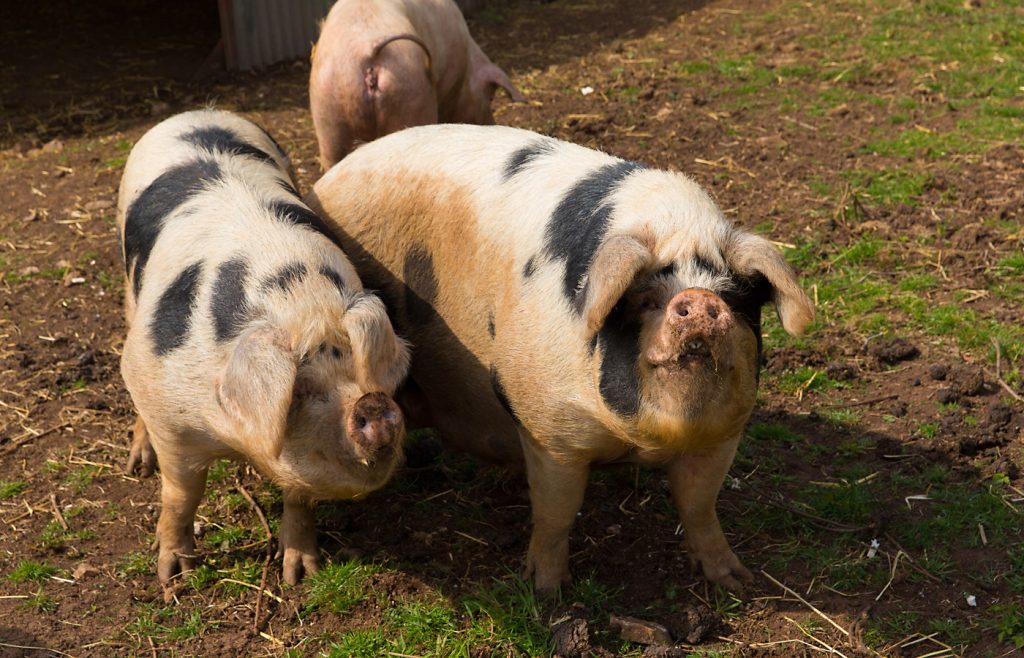
As the farmer threw a scoop of corn on the ground and called his pigs, he told his guest, “Watch this.” The pigs ran frantically towards the corn, sniffed it, then stared back at the farmer and refused to eat. The farmer then scooped corn from another bin and flung it nearby. The pigs ran over and devoured it.
“The first corn is genetically engineered,” he said. “They won’t touch it.”
It’s not just pigs. Chickens in South Africa, buffalo in India, geese in Illinois, as well as elk, deer, raccoons, squirrels, mice, and rats have all be seen avoiding genetically modified organisms (GMOs) when given a choice.
Doctors Prescribe “No GMOs”
No one knows why animals refuse GMOs, but according to the American Academy of Environmental Medicine (AAEM), people should follow their example. AAEM cites a host of problems in lab animals fed GMOs, including infertility, immune problems, accelerated aging, dysfunctional insulin and cholesterol regulation, and damage to major organs and the gastrointestinal system. They called on physicians to prescribe non-GMO diets to all patients.
“Physicians are probably seeing the effects in their patients, but need to know how to ask the right questions,” says former AAEM President Dr. Jennifer Armstrong. In fact, many experts believe that when GMOs were introduced in 1996, they were a major factor in the subsequent upsurge in disorders, which included chronic illnesses, allergies, autism, infertility, diabetes, and infant health problems.
Poison Producers
The five major genetically modified (GM) food crops are soy, corn, cotton, canola, and sugar beets. All are engineered to drink poison. They’re outfitted with bacterial genes that allow them to survive deadly doses of toxic herbicide.
Some GM varieties of corn and cotton are poison producers, equipped with a gene from the soil bacterium Bacillus thuringiensis to produce insect-killing Bt-toxin. The bacterium by itself has been used for decades as a pesticide. When it was dispersed by plane to kill gypsy moths in Washington and Vancouver, about 500 people reported allergy or flu-like symptoms. Now these same symptoms are being reported by thousands of Indian farm workers who handle Bt cotton—which is engineered to produce a more toxic version of the spray within every plant cell. Moreover, thousands of Indian sheep, buffalo, and goats died after grazing on Bt cotton plants. I visited one village where all 13 buffalo died after eating Bt cotton plants for a single day. They had been eating natural cotton plants for years without incident.
About two dozen U.S. farmers say thousands of pigs or cows became sterile from Bt corn varieties. And the corn is implicated in deaths of cows, horses, water buffaloes, and chickens. Numerous rodent studies show that Bt corn causes immune reactions and signs of toxicity.
Dangers of GM Soy
Ohio allergist Dr. John Boyles says, “I used to test for soy allergies all the time, but now that soy is genetically engineered, it is so dangerous that I tell people never to eat it.”
The danger is greater for pregnant moms and children. After GM soy was fed to female rats, most of their babies died—compared to a 10 percent deaths among controls fed natural soy. GM-fed babies were smaller and possibly infertile.
Testicles of rats fed GM soy changed from the normal pink to dark blue. Mice fed GM soy had altered young sperm. Embryos of GM soy-fed parent mice had changed DNA.
The only published human feeding study revealed that genes inserted into GM soy transfer into bacteria inside our intestines and continue to function. (If Bt genes also transfer, eating GM corn chips might transform our intestinal bacteria into living pesticide factories.)
Warnings by Government Scientists Ignored
According to documents released from a lawsuit, FDA scientists repeatedly warned that GM foods can create hard-to-detect allergies, poisons, new diseases, and nutritional problems. But the first Bush White House ordered the agency to promote biotechnology. So they brought in Michael Taylor, the former attorney of biotech giant Monsanto, to head up the FDA’s GMO policy. That policy ignored the scientists and declares that Monsanto and others can determine if their own foods are safe. There are no required safety studies. After leaving the FDA, Taylor later became Monsanto’s vice president. In 2009, he was reinstalled at the FDA as the U.S. Food Safety Czar.
Consumer Rejection of GMOs
Let’s learn our lesson from the animals and take the doctors’ advice. If even a small percentage of U.S. consumers rejected them—perhaps 5 percent, food companies would quickly replace GM ingredients. In Europe, when the tipping point was achieved in April 1999, within a week virtually all major food companies committed to stop using GMOs. U.S. consumer concerns about the cancer link from GM bovine growth hormone in milk has kicked it out of products by Wal-Mart, Starbucks, Dannon, Yoplait, and most U.S. dairies.
The Institute for Responsible Technology’s Campaign for Healthier Eating in America is engineering a tipping point against GMOs in the U.S.—and it’s taking off. The fastest growing claim among store brands in 2009 was “GMO-Free,” and Supermarket News predicts that 2010 will see an unprecedented upsurge in consumer concern about GMOs. Visit www.ResponsibleTechnology.org to reclaim an Non-GMO food supply
Jeffrey M. Smith is the Executive Director of the Fairfield-based Institute for Responsible Technology (IRT). His first book, Seeds of Deception, is the world’s bestselling book on GMOs. To find out what GMOs are in the food you buy, consult The Non-GMO Shopping Guide.
